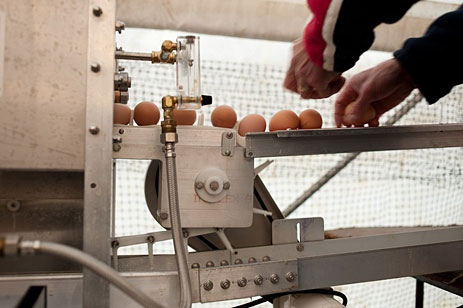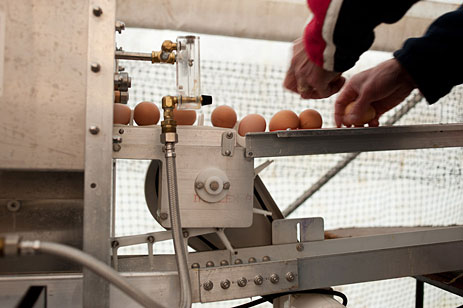 What’s HACCP-ening?: Egg-washing practices at small farms like this one come under scrutiny in Congress’s current food-safety bill. Photo: Bart NagelIt’s been a long two years since Congress started debating the passage of a new food safety law. While our legislators were busy pontificating, wave after wave of contaminated-food recalls washed across the country, leaving unsuspecting eaters gagging in their wake. Meanwhile, the internet has surged with rumors claiming that if passed, the bills will give the FDA the power to outlaw organic practices or backyard food-growing.
What’s HACCP-ening?: Egg-washing practices at small farms like this one come under scrutiny in Congress’s current food-safety bill. Photo: Bart NagelIt’s been a long two years since Congress started debating the passage of a new food safety law. While our legislators were busy pontificating, wave after wave of contaminated-food recalls washed across the country, leaving unsuspecting eaters gagging in their wake. Meanwhile, the internet has surged with rumors claiming that if passed, the bills will give the FDA the power to outlaw organic practices or backyard food-growing.
Those rumors aren’t true, but they’re based on a real concern for how the bills will affect small farms and food businesses — businesses that face enough challenges without having to worry about new federal regulations. So here’s the conundrum. We have serious food safety issues in this country. When the Senate takes up the Food Safety Modernization Act (S. 510), in a few weeks, how can it protect eaters without throwing small and midsized farms and businesses under the bus?
Red tape for leafy greens
In the town where I grew up, my neighbors are something of a local legend. Owners of one of the first certified organic farms in the region, they helped launch our farmers market, paving the way for four others in nearby towns. If you miss them at the market, you can pick up some produce at their farm stand on our road — self-serve, with an honor-system cash box — or head down to our town’s one restaurant for a serving of their greens.
By all measures of local-foodism, they’re a success. But two winters ago, they were distraught. A new supermarket opened in the adjacent town and when they inquired about selling produce there, they were handed a hefty application. To sell to the store, they’d have to implement the company’s detailed food-safety protocol on their farm and get an audit to show they were in compliance with the company’s rules.
The protocol was a nightmare. It prohibited them from having “any animals near the growing area,” which meant that their sheep pasture — separate from but adjacent to a field where crops were planted — would probably not pass muster. The vegetation lining a stream that cuts through their property was also probably not OK, since it could “harbor wildlife.” (Which wildlife were food safety problems, or why, the rules did not say.) The company’s requirements seemed directly to contradict things they had to do to earn their organic certification. And the time and money necessary to implement the plan, fill out the paperwork, and get audited were totally overwhelming.
These kinds of requirements are the new reality for small farmers looking to expand beyond the Saturday market and sell to grocery stores, wholesalers, or institutions. In my neighbors’ case, if they had wanted to sell to the supermarket, a local hospital, and a produce distributor, they would’ve had to follow three different sets of food safety rules along with their organic certification requirements.
And so for now, they’re not selling to any of them.
The gulf between large and small
Our country has a polarized food system. On one side, industrial farms and processors churn out food for the masses — food that is increasingly linked to scary contamination outbreaks. On the other side, so-called “micro farms” and processors sell directly to consumers through farmers markets, farm stands, and Community Supported Agriculture programs.
Somehow, we need to fill in the middle. Small farms like my neighbors and small processors should have every opportunity to expand beyond the farmers market. At the same time, institutions, grocery stores, and wholesalers are asking for some assurance that the food they buy — from whatever source — has been produced in a way that minimizes food safety risks.
Is it too much to ask for both? That’s a question sitting before Congress right now, and it could be answered before the year is through.
It’s high time — past high time — to do something about the dreadful state of our food safety system. We won’t soon forget the half a billion eggs recalled for salmonella contamination last month, nor the 2009 peanut product recall that affected nearly 4,000 products, nor the E. coli-contaminated spinach that sickened hundreds in 26 states in 2006. I don’t want to die of death by peanut butter. If there’s salmonella in 4,000 products on my grocery store shelf, I want the FDA to be able to recall them fast.
The food industry’s approach to dealing with these problems has been for individual companies to develop their own food safety rules, often claiming they are “better” and “safer” than their competitor’s — science and farmers be damned. That’s not doing much to address food safety problems, judging by the stream of recent outbreaks. Bad actors are not being caught before they release pathogens into the marketplace.
What this industry-controlled approach to food safety is doing, though, is keeping small and midsized farms and processors from expanding into these markets if they cannot or will not comply with the companies’ requirements. That’s why many organizations (including the one I work for), have urged Congress to get involved and set some consistent, reasonable food safety standards — and by “reasonable,” I mean standards that will protect consumers while also ensuring that small farmers and processors don’t go out of business because of them.
Last year, the House passed its food safety bill, H.R. 2749, which strengthens standards for products regulated by the FDA (produce, processed foods, eggs). As soon as mid-November, the Senate could vote on its version, S. 510. Both bills have come under fire from all sides. Big processors don’t want to be regulated or inspected as frequently as Congress is proposing, while consumer groups want them inspected more frequently. Big farms want food safety standards that work for them, which inevitably don’t work for the smaller guys; sustainable ag and family farm groups want rules that work for small, midsized, and diversified operations.
At this point, both the House and Senate bills have some good stuff in them. They also need improvement to ensure that both consumers and small farms and processors are protected. Here’s a quick rundown of what’s in the bills, and what else needs to be:
Common ground
Both bills
- Cover produce, eggs, and processed foods — things the FDA regulates — but not meat, which is regulated by the USDA.
- Would give the FDA the authority to require companies to recall contaminated products (currently, the agency can only ask nicely).
- Increase the frequency of FDA inspections of food processing facilities and would require these facilities to create detailed food safety plans and implement them.
These are all big improvements over the current system. The bills also instruct the FDA to create safety standards for farms growing produce, such as how manure or pesticides are stored. This is the biggest area of contention; depending on how they’re written, these standar
ds could be very difficult for smaller or more diversified farms to meet. One positive note is that both bills instruct FDA to consider organic practices, conservation programs, and wetland protection efforts as they develop any on-farm standards. And these standards, which the FDA will develop after the bill passes, will be subject to public input — of which, if this legislative process is any indication, there will be plenty.
Where the Senate bill is better than the House bill
The Senate bill doesn’t charge businesses any fees for inspection. In contrast, the House bill would charge $500 per food-processing facility to generate revenue for the FDA’s inspection program. (Many small processors object to being charged the same amount as larger facilities and are concerned that this fee is too burdensome, which when you think about a farmers-market jam maker versus a Smucker’s plant, it is.)
Although both bills instruct the FDA to consider the impact that any new regulation could have on organic, small-scale, or direct marketing farm or food processors, and to consider the impact on conservation programs and practices, the Senate’s instructions are clearer. And S. 510 includes a program that offers technical assistance and education for small farms, providing grants to groups that could help farmers like my neighbors figure out how to implement food safety practices on their farm. (More small farmer/processor-friendly additions have been developed in a managers’ amendment [PDF] — changes to the bill that have been negotiated with both sides in advance, increasing their chances of passing — that will probably be passed if the Senate ever actually takes up the bill.)
Where the Senate bill is weaker than the House bill
S. 510 requires the FDA to inspect high-risk food processors — think the Peanut Corporation of America — only once every five years, and low-risk processors every seven years. That wouldn’t have caught the salmonella that spread like … well, creamy peanut butter, out of PCA’s Georgia facility in 2006, 2007, and 2008. On the other hand, the House bill requires high-risk operations to be inspected by the FDA every six to 12 months, and low-risk facilities every one to three years.
The Senate bill is also weaker on the standards it would impose on foreign processors that export to the United States. That means that U.S. companies (or foreign ones) operating abroad wouldn’t have to meet standards as strict as those at home. Great idea … if you like your coffee with a dash of melamine.
S. 510 and small farms: A Tester case
It’s important to remember that the vast majority of our food system is controlled by a few giant companies. That’s why one food safety mishap sends the whole country running for the toilet. We need regulations that can protect us against this kind of madness.
But we also need to make sure that if my neighbors want to sell to the local supermarket, they won’t be stymied by food safety requirements they can never meet. The Senate bill deals with this in part — see above — but it could do more. Enter Sens. Jon Tester (D-Mont.) and Kay Hagan (D-N.C.).
The Tester-Hagan amendment to S. 510 would exempt small farms and food processing businesses, meaning those that meet the definition of “small” or “very small,” that make under a certain amount of money, and that earn at least 50 percent of their revenue from direct-to-consumer sales (like farmers markets or CSAs), from some of the bill’s requirements. It would also require the FDA to study where our food safety problems are coming from — if they’re overwhelmingly associated with certain kinds of processing methods or certain sizes of operation. Hmm — I wonder what they’ll find?
These are good additions to the bill, and the Senate should pass the amendment when it takes up S. 510. (You can tell your senators as much by taking action here.)
It’s time to take food safety out of the realm of company marketing and place it squarely where it belongs: in the realm of the federal government, which is responsible for ensuring that the simple act of eating does not require us to take our lives into our own hands. But building a safer food system also means that these new rules must help — not prevent — small farmers and processors from taking the next step and expanding into larger markets.
The alternative to Congress taking action is allowing the big food companies to continue to write the rules. That would mean limiting my town’s access to sustainable food from our local farm to a few summer Saturdays — along with a whole lot of much bigger consequences.



